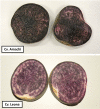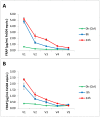Effects of Simulated Human Gastrointestinal Digestion of Two Purple-Fleshed Potato Cultivars on Anthocyanin Composition and Cytotoxicity in Colonic Cancer and Non-Tumorigenic Cells
- PMID: 28850070
- PMCID: PMC5622713
- DOI: 10.3390/nu9090953
Effects of Simulated Human Gastrointestinal Digestion of Two Purple-Fleshed Potato Cultivars on Anthocyanin Composition and Cytotoxicity in Colonic Cancer and Non-Tumorigenic Cells
Abstract
A dynamic human gastrointestinal (GI) model was used to digest cooked tubers from purple-fleshed Amachi and Leona potato cultivars to study anthocyanin biotransformation in the stomach, small intestine and colonic vessels. Colonic Caco-2 cancer cells and non-tumorigenic colonic CCD-112CoN cells were tested for cytotoxicity and cell viability after 24 h exposure to colonic fecal water (FW) digests (0%, 10%, 25%, 75% and 100% FW in culture media). After 24 h digestion, liquid chromatography-mass spectrometry identified 36 and 15 anthocyanin species throughout the GI vessels for Amachi and Leona, respectively. The total anthocyanin concentration was over thirty-fold higher in Amachi compared to Leona digests but seven-fold higher anthocyanin concentrations were noted for Leona versus Amachi in descending colon digests. Leona FW showed greater potency to induce cytotoxicity and decrease viability of Caco-2 cells than observed with FW from Amachi. Amachi FW at 100% caused cytotoxicity in non-tumorigenic cells while FW from Leona showed no effect. The present findings indicate major variations in the pattern of anthocyanin breakdown and release during digestion of purple-fleshed cultivars. The differing microbial anthocyanin metabolite profiles in colonic vessels between cultivars could play a significant role in the impact of FW toxicity on tumor and non-tumorigenic cells.
Keywords: anthocyanins; antioxidant; biotransformation; cancer cells; cytotoxicity; human gastrointestinal model; purple-fleshed potato.
Conflict of interest statement
The authors declare no conflict of interest.
Figures





References
-
- Takeoka G., Dao L. In: Methods of Analysis for Functional Foods and Nutraceuticals. 1st ed. Hurst W.J., editor. CRC Press LLC; Boca Raton, FL, USA: 2002.
-
- Brown C.R., Wrolstad R., Durst C.-P., Yang B.A. Clevidence, Breeding studies in potatoes containing high concentrations of anthocyanins. Am. J. Potato Res. 2003;80:241–250. doi: 10.1007/BF02855360. - DOI
-
- Ieri F., Innocenti M., Andrenelli L., Vecchio V., Mulinacci N. Rapid HPLC/DAD/MS method to determine phenolic acids, glycoalkaloids and anthocyanins in pigmented potatoes (Solanum tuberosum L.) and correlations with variety and geographical origin. Food Chem. 2011;125:750–759. doi: 10.1016/j.foodchem.2010.09.009. - DOI
-
- Bellumori M., Innocenti M., Michelozzi M., Cerratini L., Mulinacci N. Coloured-fleshed potatoes after boiling: Promising sources of known antioxidant compounds. J. Food Compos. Anal. 2017;59:1–7. doi: 10.1016/j.jfca.2017.02.004. - DOI
Publication types
MeSH terms
Substances
LinkOut - more resources
Full Text Sources
Other Literature Sources

